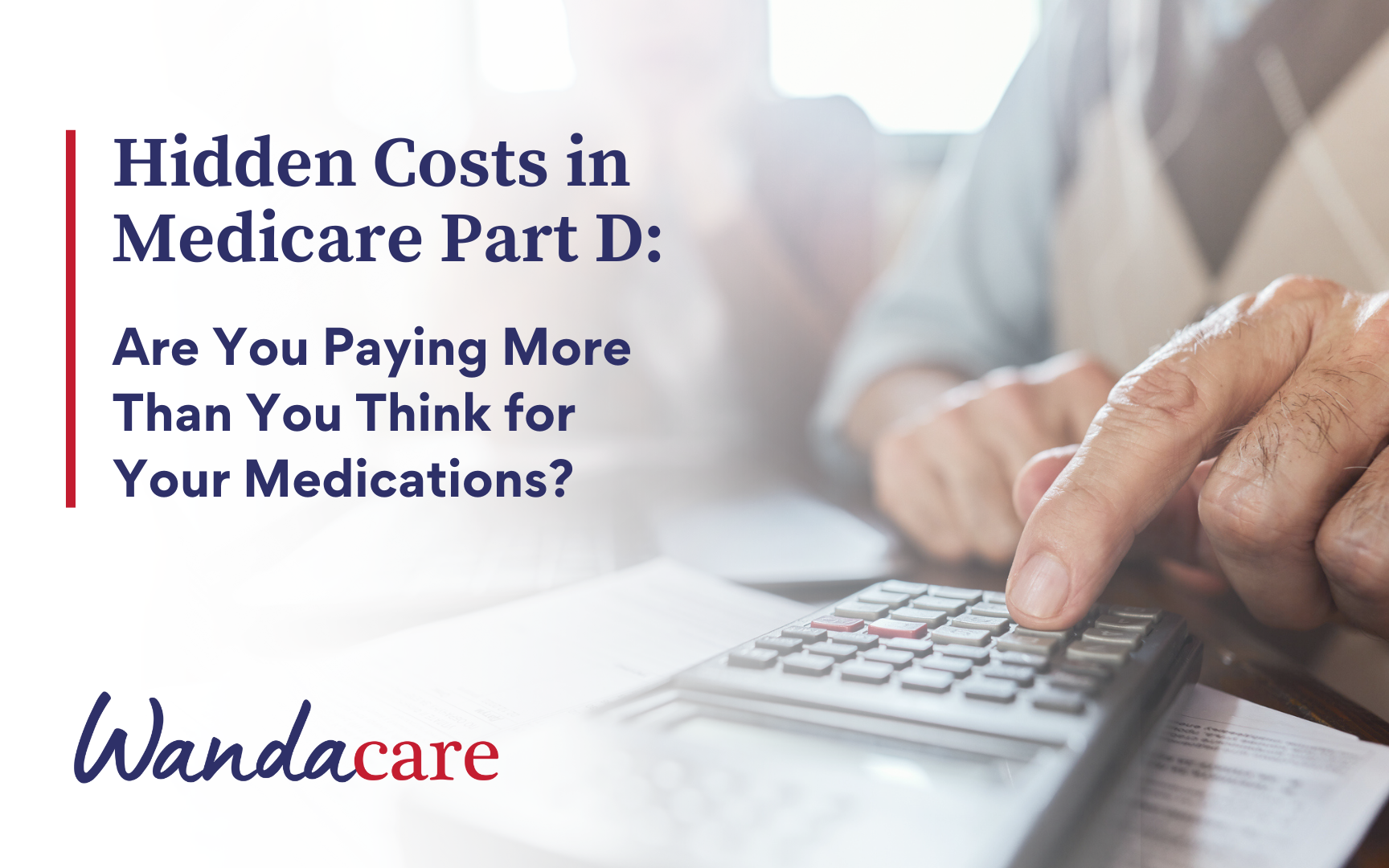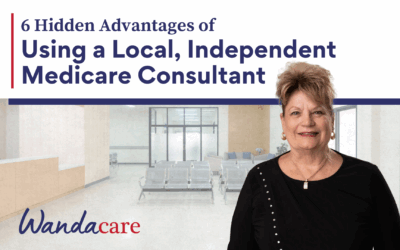Medicare Part D keeps prescription drug costs affordable for seniors, but don’t be surprised if your medications cost more than what you expected. That’s because there are hidden costs lurking in Part D plans that can leave you feeling squeezed, especially as drug manufacturer prices (and profits) continue to increase and plans exclude or impose restrictions on more medications. You can quickly find yourself struggling to afford and even access the vital prescriptions you need.
Take charge of your prescription drug coverage and expenses by knowing the hidden costs to look for and the strategies that can help you save on your Medicare Part D plan—starting with the expert guidance from Wandacare, your licensed Florida Medicare advisor.
What is Medicare Part D and What Does It Cost?
Medicare Part D prescription drug plans are offered by private insurance companies and supplemented by Medicare. Part D is separate, optional coverage and not included in federally managed Original Medicare (or Medicare Parts A and B). You can choose to add a private Part D prescription drug plan to Original Medicare, or if you choose a privately insured Medicare Advantage Plan (or Medicare Part C) for your Medicare coverage, your Part D coverage will be bundled with Parts A and B in the Advantage Plan, along with any additional benefits the private insurer offers.
As all Part D options are privately backed plans that you purchase, you’ll be paying something for your prescription drug coverage. These are the up-front costs to be aware of and compare between Part D plans:
Monthly Premiums: This is the amount you’ll pay every month for your drug plan coverage.
Annual Deductible: Before your Part D plan starts covering drug costs, you may have to meet an annual deductible. Typically, the higher the annual deductible, the lower the monthly premium.
Cost Sharing: After meeting the deductible, you’ll pay a percentage of the drug costs, either as a copayment or coinsurance.
Tiered Drug Pricing: To know what you’ll pay for a particular drug, look at the plan’s formulary—a listing of the drugs covered and their “tier,” which determines what you’re responsible for paying out-of-pocket for that medication. The drug cost is based on the “tier” it is in:
- Tier 1 drugs typically include generic medications with lower copays.
- Tier 2 and Tier 3 drugs include brand-name medications, which often come with higher copays or coinsurance.
- Tier 4 and Tier 5 drugs include specialty drugs, often with the highest costs.
The Hidden Costs in Medicare Part D Plans
While the annual deductible, monthly premium, your cost-sharing responsibilities, and drug prices are all plan expenses you can know and budget for up front, there can be hidden costs lurking in Part D prescription drug plans.
Here are some common “hidden” costs to keep in mind and prepare for:
Prescription Changes and Drug Tier Pricing
Before you choose a Part D plan, you’ll want to review and compare plan formularies, tier structures, and drug costs to ensure any prescription medications you’re currently taking are covered at the lowest cost to you. This can help you know what you’ll pay for prescription drugs you have now, but what happens when your prescriptions change?
With illness and age, your prescription drug list will most likely grow—and so will the costs. The medications you are prescribed may be in higher tiers with significantly higher costs. In some cases, the drugs may not be covered at all by your plan, leaving you to pay full price. While it can be hard to plan for the unknown, a change in your medication needs prescription needs is something you need to anticipate—and budget for.
Medication Price Increases
Just as you can’t know what prescription drugs you’ll need in the future, you can’t know what the future drug prices will be—even for the prescription drugs you have now. Prescription drug prices are not static and often increase over time, outpacing inflation, which can lead to higher out-of-pocket expenses. Even if a drug was affordable at the start of the year, price hikes can occur unexpectedly, causing you to pay more without warning.
Late Enrollment Penalties
Delaying enrollment in a Part D plan can lead to late penalties that last the life of your plan. If you do not enroll in a Medicare Part D plan when you first become eligible during your Medicare Initial Enrollment Period (IEP), and go without Part D or other creditable prescription drug coverage for 63 days or more in a row, you’ll be assessed the late enrollment penalty (LEP).
The penalty is calculated by multiplying 1% of the monthly “national base beneficiary premium” ($34.70 in 2024) times the number of full months you didn’t have Part D or creditable coverage. The monthly premium is rounded to the nearest $.10 and added to your monthly Part D premium. Once the late enrollment penalty is added to your monthly Part D premium, you’ll have to pay the assessed penalty for as long as you have Medicare drug coverage. Your LEP will be recalculated every year and will be based on that year’s national base beneficiary premium.
How to Save on Your Prescription Drugs and Medicare Part D Plan
While Medicare Part D may have its hidden costs, you don’t have to be surprised by them. There are several proactive steps you can take to help reduce plan costs and your prescription drug expenses.
Compare Plans During Open Enrollment
You have the opportunity to review and update your Part D prescription drug coverage every year during the Medicare Annual Enrollment Period, which runs from October 15 to December 7. If your Part D coverage is part of a Medicare Advantage Plan, you’ll have a second opportunity to make a single change during the Medicare Advantage Open Enrollment Period.
Since drug plans can change their premiums, deductibles, and formularies annually and drug prices can increase unexpectedly, it’s essential to use these yearly enrollment periods to explore Part D options to ensure you’re still in the most cost-effective plan. Compare different plans based on your specific prescriptions and look for plans with the lowest premiums or most comprehensive coverage for your medications.
Consider Generic Drugs and Drug Alternatives
Ask your healthcare provider if there are generic or lower-tier alternatives for your medications. Generic drugs are usually in the lowest tier and cost significantly less than their brand-name equivalents. If your current drug is in a higher tier, finding a suitable generic alternative can save you hundreds of dollars annually.
Also, inquire about drug alternatives or treatments. Your doctor may be able to prescribe different medications that are equally effective but more affordable. Often, therapeutic alternatives exist that can reduce costs without compromising your treatment.
Use Mail-Order Pharmacies
Many Medicare Part D plans offer mail-order pharmacy services, which can save money on prescriptions, especially for long-term medications. Mail-order services often provide a 90-day supply at a lower cost compared to retail pharmacies, reducing monthly trips and out-of-pocket expenses.
Apply for Extra Help and Assistance Programs
The Extra Help program, administered by the Social Security Administration, helps low-income seniors with their Medicare Part D costs. Anyone who has already qualified for Medicaid, a Medicare Savings Program, or Supplemental Security Income benefits automatically qualifies for the Extra Help program. You can also apply and qualify based on income limitations. If you qualify, Extra Help can cover premiums, deductibles, and copayments, reducing your out-of-pocket expenses.
Additionally, some drug manufacturers offer assistance programs for seniors struggling to afford their medications. These programs, known as Patient Assistance Programs, can provide free or low-cost drugs if you meet certain income and insurance criteria.
Make Informed Medicare Part D Decisions with Wandacare
Medicare Part D provides you with the affordable prescription drug coverage you need. However, not all plans are created equal and their total costs to you may not be obvious. Being proactive about your prescription drug coverage can ensure you receive the medications you need while keeping your costs down.
This doesn’t mean you have to sweat your coverage costs or chase down plan information on your own. With over a decade of experience, Wandacare’s licensed Medicare agents and advisors can walk you through your Medicare Part D options to ensure you have a prescription drug plan that meets your needs and your budget.
Contact Wandacare today to get your Medicare Part D questions answered!




